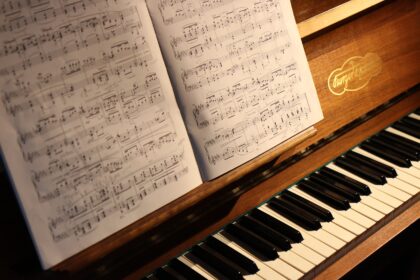What you’ll learn in this lesson
- The Staff
- Treble Clef
- Notes on Treble Clef
- Note’s Length
Call me old school, I strongly believe the best way to learn anything is to write it down by hand. When you write something down by hand, it sticks with you a lot longer.
I’m not sure how kids learn music nowadays. I do understand the new generation may have different ways of learning. You may prefer to type everything on your laptop. But trust me on this, the best way to learn music theory is to hand write all the notes, clefs, and the staff.
Let’s begin today’s lesson.
The Staff
What is the Staff and why you need to know it?
The staff consist of 5 horizontal lines and 4 spaces between these lines. Depending on which clef you put in the beginning of a staff, it will indicate the pitch of the musical notes.

Treble Clef
If you’re to draw the Treble Clef, it’ll start with a little dot from the note G and curls around the rest of the staff. Watch the video lesson to learn how.

Notes on Treble Clef

There are two ways you can call the music notes. DO, RE, MI, FA, SOL, LA, SI (TI in America). or C, D, E, F, G, A, and B. There’s no right or wrong way of doing it. But it’s best to know both.
When you sit in front of the piano, the way you line yourself is in the middle of the keyboard. That’s why it’s so easy to recognize where Middle C lies on the piano.
- You start with the first note DO or C, and you go up/ to the right of the piano. Middle C is written on a ledger line. Ledger lines are lines which are located below or above the staff. Since there are only 5 lines on the staff and 4 spaces, we have to use ledger lines to write notes which go under or above the staff.
- RE or D is located under the first horizontal line on the staff.
- MI or E is on the first horizontal line.
- FA or F falls in the space between the first and second line on the staff.
- SOL or G is on the second line.
- LA or A is in the space between the second and third lines.
- SI (TI) or B is on the third horizontal line.
- Then we start from DO or C again and we continue to go up the scale. This C lies in the space between the third and forth lines.
- RE or D is on the forth line.
- MI or E is in the space between forth and fifth lines.
- FA or F is on the fifth horizontal line.
- And so on…You’ll notice that A, B, and C are written on ledger lines above the staff since there’re no more staff lines.

Note’s Length
You may ask yourself, how do musicians know what tempo to use in each measure. Some songs are played slower than others. This is because notes have different length. Some are played faster than others.
Below are the most common notes you’ll see on a sheet of music:


Homework
Try to memorize as many as you can. Write them down 10 times each and repeat the length they each have.










